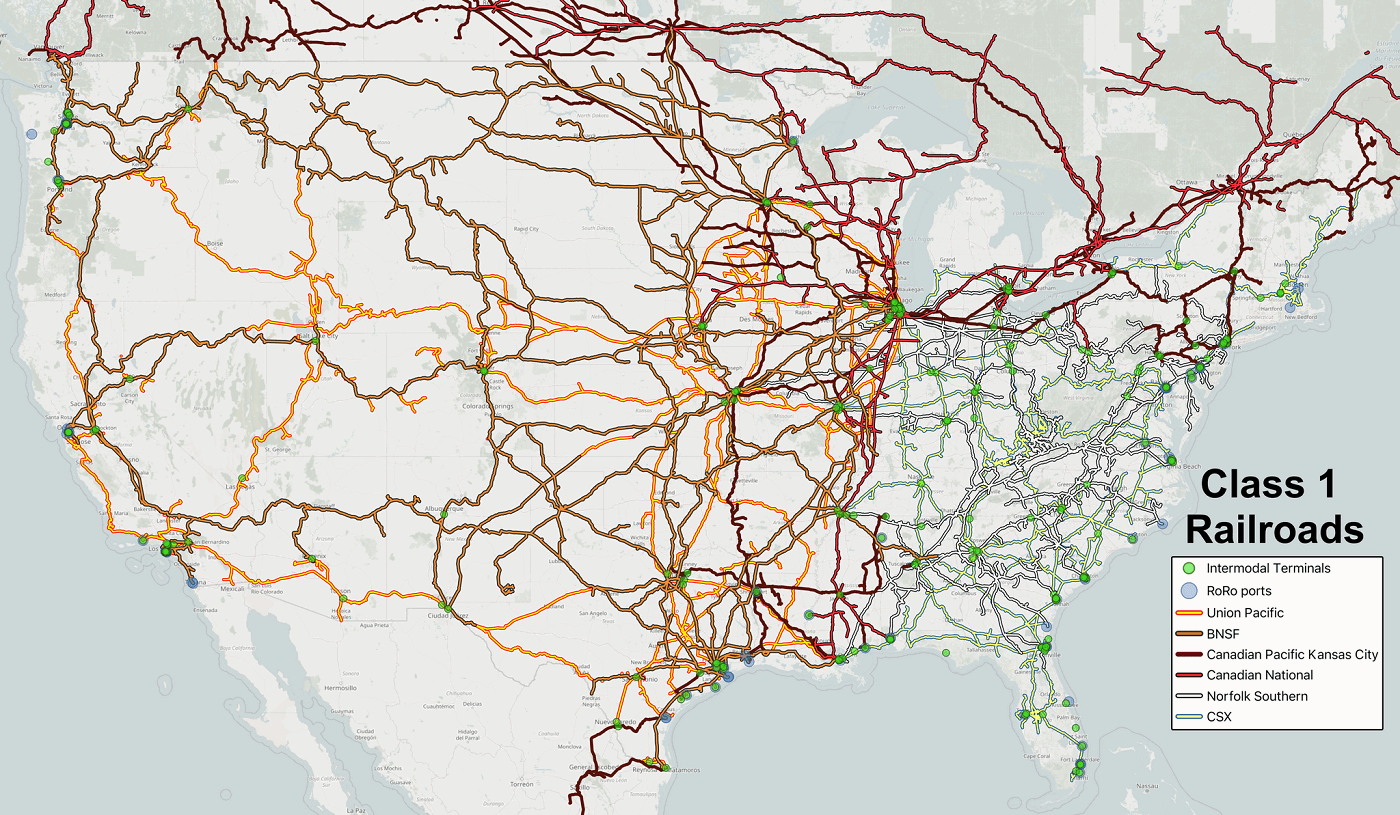Railroad shipping companies. A guide for the U.S. railroad industry
With a potential merger between Union Pacific and Norfolk Southern, the first carrier capable of transporting freight from coast-to-coast could emerge. The railroad freight industry is a growing market that offers several advantages over other modes of transportation. In this article, we explore the key characteristics of the industry, examine the advantages and disadvantages of rail freight transport, and list the most important railroad shipping companies.

Characteristics of the U.S. rail freight transport industry
The U.S. rail freight transport industry is estimated to reach a market size of $71.77 billion in 2025, with a projected growth to $84.79 billion by 2030. Freight railroads handle approximately 40% of all U.S. long-distance freight, measured in ton-miles.
Intermodal transport is the primary growth driver, driven by the continued rise of e-commerce. In 2024, intermodal freight accounted for 46% of total rail freight volume, with a year-over-year growth of 8.5%.
The petrochemical boom along the Texas–Louisiana Gulf Coast is another key contributor to the sector’s expansion, resulting in increased demand for bulk transport via rail.
The U.S. railroad network spans more than 140,000 miles, operated by:
- 7 Class I railroads. National carriers with annual revenues above $1.05 billion, owning and maintaining extensive rail infrastructure.
- 22 Class II railroads. Regional carriers with revenues between $47 million and $1.04 billion, serving as critical connectors between national and local rail lines.
- 584 Class III railroads. Short-line and local operators responsible for essential first-mile and last-mile logistics.
Advantages of railroad freight transport
Rail freight transport offers several key advantages over road, air, and maritime shipping, which contribute to the growth of railroad shipping.
- Economies of scale. Rail is very suited for transporting large volumes of heavy or bulky cargo, such as raw materials, machinery, and industrial components. This leads to lower costs per ton-mile.
- More fuel-efficient over long distances. For shipments spanning hundreds or thousands of miles, rail is more fuel-efficient and economical than road transport.
- Lower carbon emissions. Trains emit significantly less CO₂ per ton-mile compared to trucks and planes. This makes rail a more sustainable choice and allows businesses to reduce their carbon footprint.
- Reduced road congestion. Moving freight by rail eases pressure on highways and helps reduce traffic and infrastructure wear.
- Reliable transit schedules. Rail networks are less affected by weather and traffic delays, ensuring consistent delivery times for time-sensitive shipments. However, Journal of Commerce surveys indicate that many rail freight customers remained dissatisfied with service performance in the second half of 2024, citing missed pick-ups and inconsistent transit times as key concerns.
- Enhanced safety. Rail transport is statistically one of the safest modes of freight transportation. The risk of accidents and cargo theft is much lower compared to road transport, providing greater security for valuable or hazardous materials.
- Intermodal compatibility. Rail integrates seamlessly with truck and port logistics, making it ideal for intermodal solutions in global supply chains.
Rail freight is particularly well-suited for sectors such as manufacturing, energy, agriculture, and logistics, where reliable and cost-effective transport is important.
Disadvantages of railroad freight transport
While rail freight offers many benefits, there are also limitations compared to road, air, or maritime transport.
- Limited network access. Rail transport requires access to railway infrastructure. Many businesses are not located near rail terminals, requiring additional trucking for first-mile and last-mile delivery.
- Less flexibility. Unlike trucks, trains operate on fixed routes and schedules. This lack of flexibility makes rail transport less suitable for urgent deliveries, unexpected shipments, or destinations not located near a rail line.
- Slower transit times. While a train can be faster than a truck over long distances, the overall transit time can be longer. This is due to the time required for loading and unloading, sorting railcars in classification yards, and transferring freight between different modes of transport. A shipment might switch trains multiple times before reaching its final destination.
- Not suitable for short distances. The time and cost involved in organizing rail transport, combined with the need for trucking at both ends, make it inefficient and less competitive for short-distance routes.
- Higher initial investment. Shipping by rail often involves coordination with freight operators, terminal handling fees, and infrastructure costs that may not be viable for low-volume shipments.
- Capacity and scheduling constraints. Congestion on key rail corridors or limited availability of railcars can lead to delays, especially during peak seasons.
- Complex coordination. Intermodal transport involving rail requires additional planning and handling compared to direct trucking, which can increase administrative workload.
- Theft. Railcar theft in on the rise, creating financial damages and disrupting supply chains. However, truck cargo theft is on the rise as well.
For certain use cases, particularly short-haul or low-volume shipments, road or air transport may offer better speed, flexibility, and responsiveness.
List of Class I Railroad freight companies
- BNSF Railway. Owned by Berkshire Hathaway, BNSF operates the largest freight rail network in North America. Visit website.
- Union Pacific Railroad (UP). Covers the western two-thirds of the U.S., with strong intermodal and agricultural freight operations. Visit website.
- CSX Transportation (CSX). Serves the eastern U.S., including major ports and industrial hubs. Visit website.
- Norfolk Southern Railway (NS). Focuses on the southeastern and midwestern U.S., with strong intermodal and coal transport capabilities. Visit website.
- Canadian National Railway (CN). Although based in Canada, CN operates significant routes in the U.S., including Chicago, Memphis, and New Orleans. Visit website.
- Canadian Pacific Kansas City (CPKC). Formed from the 2023 merger of Canadian Pacific and Kansas City Southern, CPKC is the first single-line railway connecting Canada, the U.S., and Mexico. Visit website.
The attentive reader will notice that one Class I railroad freight company is missing. Amtrak is a Class I railroad company, but Amtrak is a national passenger rail service and not classified as a Class I freight railroad.

Overview Class I railroads in the U.S.
List of Class II Railroad freight companies
- Alabama and Gulf Coast Railway (AGR). Purveys regional freight across the Gulf Coast. Visit website.
- Alaska Railroad (ARR). Key freight carrier in Alaska. Visit website.
- Buffalo and Pittsburgh Railroad (BPRR). Serves New York and Pennsylvania. Visit website.
- Dakota, Missouri Valley and Western Railroad. Operates in the Dakotas and Montana. Visit website.
- Decatur and Eastern Illinois Railroad. Freight service in Illinois region. Visit website.
- Evansville Western Railway. Traffic operations in Indiana and Illinois. Visit website.
- Florida East Coast Railway (FEC). East‑Florida freight transportation. Visit website.
- Indiana Rail Road (INRD).Freight movements across Indiana and connections. Visit website.
- Iowa Interstate Railroad (IAIS). Operates across Iowa, Nebraska and Illinois. Visit website.
- Kansas and Oklahoma Railroad. Regional freight in Kansas and Oklahoma. Visit website.
- Kyle Railroad. Freight carrier in Kansas and Colorado. Visit website.
- Nebraska Kansas Colorado Railway. Regional freight line between those states. Visit website.
- New England Central Railroad. Serves freight needs in New England region. Visit website.
- New York, Susquehanna and Western Railway (NYSW). Freight across NY, NJ, and PA. Visit website.
- Paducah and Louisville Railway. Freight carrier in Kentucky. Visit website.
- Portland and Western Railroad. Freight operations in Oregon. Visit website.
- Providence and Worcester Railroad. Freight in New England, notably Rhode Island area. Visit website.
- Rapid City, Pierre and Eastern Railroad. Serves freight in South Dakota and surrounding areas. Visit website.
- Red River Valley and Western Railroad. Freight across North Dakota region. Visit website.
- Toledo, Peoria and Western Railway. Freight service in Illinois region. Visit website.
- Wheeling and Lake Erie Railway. Freight service in Ohio, Pennsylvania, and West Virginia. Visit website.
- Wisconsin and Southern Railroad. Operates freight in Wisconsin and northeastern Illinois. Visit website.
A complete list of the 584 Class III railroads unfortunately falls outside the scope of this article.
About Hoefon Security Seals
Hoefon Security Seals is a certified supplier of railcar seals for protecting goods during transports. We offer both ISO 17712 certified high security seals as well as indicative seals for sealing empty railcars. We also offer damage indicators and transport monitoring tools to help you monitor your goods during transport. Moreover, we are experts in designing tailor-made anti-tampering solutions for our customers. Please feel free to contact us for more information.
For businesses looking to use railroad freight transport, leasing railcars can be a smart and flexible option. You can find more information about different types of railcars in our article about railcar types.

Niels Pas
CEO Hoefon Security Seals
Niels Pas has been Hoefon Security Seals’ CEO since 2017. He has extensive international experience and speaks 4 languages professionally.


